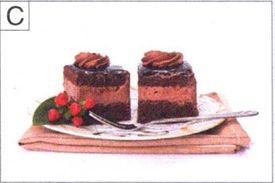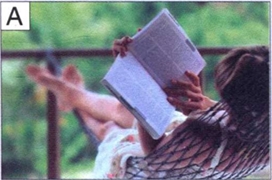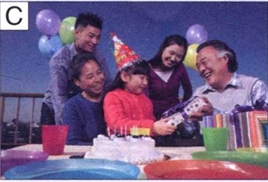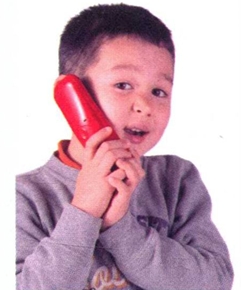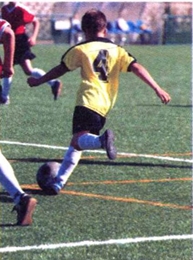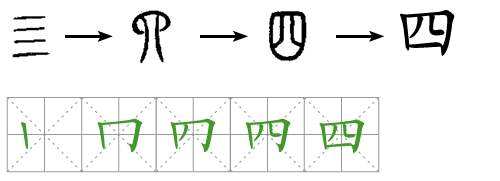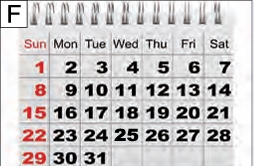热身 1 Warm-up
给下面的词语选择对应的图片 Match the pictures with the words.





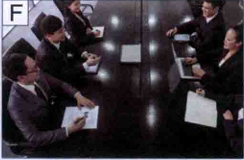
gǎnxiè ① 感谢 ________
tán shēngyì ② 谈 生意 ________
zhīshi ③ 知识 ________
ànshí ④ 按时 ________
zhuàn qián ⑤ 赚 钱 ________
shǒumáng-jiǎoluàn ⑥ 手忙脚乱 ________
2
你觉得下面四种工作哪个最容易完成?哪个最难?说说为什么。
Which of the four tasks below is the easiest to fulfill? Which is the hardest? Talk about why.
① 用一个星期的时间调查(diào chá) 1000个人换工作的原因。
② 一个人用一天时间写一份公司全年的工作计划。
③ 每天提前(tián qián) 半个小时到公司。
④ 用一个月时间把自己的工作经验(jīng yàn) 教给新来的同事。
课文1 小林和小李聊小李的工作
小林:听说你又换工作了?今年已经换了三次工作了吧?
小李:别提了!我以为新工作比以前的好,没想到还没有以前好呢。
小林:上次那份工作你只做了两个月就离开了,其实,完全适应一个新的工作需要一年时间,所以,经常换工作不一定好。
小李:我也明白。但是那份工作的收入太少了!
小林:你才到新公司,不要太急着赚钱,多学习才是最重要的。
小李:好。我一定会努力把现在这份工作做好。
生词
1. 提(tí) v. to mention
2. 以为(yǐwéi) v. to think, to believe
3. 份(fèn) m. used for jobs among other things
4. 完全(wánquán) adv. completely
5. 赚(zhuàn) v. to earn
2 王经理和小李在说工作
王经理:那份调查还要多长时间才能做完?
小李:按原来的计划应该是两周,但是我们可以提前完成,周末保证做完。
王经理:虽然最近工作很忙,但你们也要注意身体啊。
小李:谢谢您!现在有很多事情等着我做,真不知道该先做哪个好。
王经理:每天早上我都把当天计划要做的事情写在笔记本上,提醒自己安排好时间。你也可以试试这样做。
小李:这个办法真不错!这样我就不会手忙脚乱了。
生词
6. 调查(diàochá) v. to survey; to investigate
7. 原来(yuánlái) adj. original
8. 计划(jìhuà) n./v. plan; to intend to
9. 提前(tíqián) v. to do (sth.) in advance or ahead of time
10. 保证(bǎozhèng) v. to guarantee
11. 提醒(tíxǐng) v. to remind
12. 乱(luàn) adj. hurry-scurry, confused
专有名词
王(Wáng) Wang, a Chinese family name
3 王经理和马经理在说工作 04-3
王经理:什么事让你这么高兴啊?
马经理:我们和上次那个公司的生意终于谈成了。
王经理:太好了!你工作那么努力,公司会越来越好的。
马经理:我原来以为做生意很简单,后来才发现其实并不容易,现在赚钱越来越难了。
王经理:慢慢来,万事开头难,重要的是要多积累经验。
马经理:我相信经过我们大家的努力,公司的生意会越做越大,一切都会好的。
生词
13. 生意 shēngyì n. business, trade
14. 谈 tán v. to talk, to discuss
*15. 并 bìng adv. used before a negative for emphasis
16. 积累 jīlěi v. to accumulate
17. 经验 jīngyàn n. experience
18. 一切 yíqiè pron. all, every
拼音课文 Texts in Pinyin
1、Xiǎo Lín hé Xiǎo Lǐ liáo Xiǎo Lǐ de gōngzuò
Xiǎo Lín: Tīngshuō nǐ yòu huàn gōngzuò le? Jīnnián yǐjīng huànle sān cì gōngzuò le ba?
Xiǎo Lǐ: Biéti le! Wǒ yǐwéi xīn gōngzuò bǐ yīqián de hǎo, méi xiǎngdào hái méiyou yǐqián hǎo ne.
Xiǎo Lín: Shàng cì nà fèn gōngzuò nǐ zhǐ zuòle liǎng ge yuè jiù lákāi le, qíshí, wánquán shìyòng yí gè xīn de gōngzuò xūyào yí niàn shíjiān, suǒyǐ, jīngcháng huàn gōngzuò bù yídìng hǎo.
Xiǎo Lǐ: Wǒ yě míngbai. Dànshì nà fèn gōngzuò de shōurù tài shǎo le!
Xiǎo Lín: Nǐ cái dào xīn gōngsī, búyào tài jízhe zhuàn qián, duō xuéxí cái shì zuì zhòngyào de.
Xiǎo Lǐ: Hǎo. Wǒ yídìng huì nǔlì bǎ xiànzài zhè fèn gōngzuò zuòhǎo.
2、Wáng jīnglǐ hé Xiǎo Lǐ zài shuō gōngzuò
Wáng jīnglǐ: Nà fèn diàochá hái yào duō cháng shíjiān cái néng zuòwán?
Xiǎo Lǐ: Àn yuánlái de jìhuà yīnggāi shì liǎng zhōu, dànshì wǒmen kěyǐ tíqián wánchéng, zhōumò bǎozhèng zuòwán.
Wáng jīnglǐ: Suīrán zuìjìn gōngzuò hěn máng, dàn nǐmen yě yào zhùyì shēntǐ a.
Xiǎo Lǐ: Xièxie nǐn! Xiànzài yǒu hěn duō shìqing děngzhe wǒ zuò, zhēn bù zhīdào gāi xiān zuò nǎge hǎo.
Wáng jīnglǐ: Měi tiān zǎoshang wǒ dōu bǎ dāngtiān jìhuà yào zuò de shìqing xiě zài bǐjìběn shàng, tīngxùn zìjǐ ānpái hǎo shíjiān. Nǐ yě kěyǐ shìshi zhèyàng zuò.
Xiǎo Lǐ: Zhège bànfǎ zhēn bùcuò! Zhèyàng wǒ jiù bú huì shǒumáng-jiǎoluàn le.
3、Wáng jīnglǐ hé Mǎ jīnglǐ zài shuō gōngzuò
Wáng jīnglǐ: Shénme shì ràng nǐ zhème gāoxìng a?
Mǎ jīnglǐ: Wǒmen hé shàng cì nàge gōngsī de shēngyì zhōngyú tánchéng le.
Wáng jīnglǐ: Tài hǎo le! Nǐ gōngzuò nàme nǔlì, gōngsī huì yuè lái yuè hǎo de.
Mǎ jīnglǐ: Wǒ yuánlái yǐwéi zuò shēngyì hěn jiǎndān, hòulái cái fāxiàn qíshí bìng bù róngyì, xiànzài zhuǎn qián lái nán le.
Wáng Jīnglǐ: Mànmàn lái, wànshì kāitóu nán, zhòngyào de shì yào duō jǐlěi jīngyàn.
Mǎ jīnglǐ: Wǒ xiāngxìn jīngguò wǒmen dàjiā de nǔlì, gōngsī de shēngyì huì yuè zuò yuè dà, yíqiè dōu huì hǎo de.
注释 1 以为
Notes
“以为”,动词,常用来表示说话人认为的事情跟事实不符。例如:
The verb “以为” indicates what the speaker thought goes against the fact. For example:
- (1)她汉语说得那么好,我还以为她是中国人。
- (2)马克以为今天是星期一,到了学校一看,没人来上课,才发现今天是星期天。
- (3)我以为新工作比以前的好,没想到还没有以前好呢。
完成句子 Complete the sentences.
- (1)还有半小时就到了,____________________。(以为)
- (2)____________________,其实很容易。(以为)
- (3)____________________,没想到他们一直留在北京。(以为)
2 原来
“原来”,可以做名词,表示 “开始的时候、从前”,后面接的分句或句子所描述的情况跟以前的情况不同。例如:
“原来” can be used as a noun to mean “the beginning, the past”, indicating the situation described in the clause or sentence following it is different from that in the past.
For example:
- (1)坐火车从北京到上海,原来最快差不多需要12个小时,现在有了高铁,5个小时就能到。
“原来”,可以做形容词,表示 “以前的、没有改变的” 。不能单独做谓语,修饰名词时后面要加 “的” 。例如:
“原来” can be used as an adjective to mean “original, unaltered”. It cannot be used alone as the predicate. When it modifies a noun, “的” should be used after it. For example:
- (2)按原来的计划应该是两周,但是我们可以提前完成。
“原来”,还可以做副词,表示“以前某一时期”,含现在已经不是这样的意思。
“原来” can also be used as an adverb to indicate “a certain period in the past”, meaning something/somebody has changed now.
(3)她原来是汉语老师,现在已经成了一名律师。
“原来”做副词还表示“发现了以前不知道的情况”,用在主语前面或后面都可以。例如:
The adverb “原来” can also indicate the discovery of a formerly unknown situation. It can be used either before or after the subject. For example:
(4)马克一直等李明回电话,可是电话一晚上都没来,原来李明把马克的电话号码记错了。
练一练 Practise
完成句子 Complete the sentences.
(1)______________________,我几乎没认出来。(原来)
(2)______________________,不过后来发现新闻专业更适合他。(原来)
(3)今天晚上怎么这么冷?______________________。(原来)
比一比 Compare
原来—本来
相同点:Similarities:
1. 两者都可做形容词,表示“以前的、没有改变的”。
Both can be used as adjectives, indicating “original, unaltered”.
这是它原来/本来的颜色,不过现在已经穿了好几年,颜色都变了。
2. 两者都可做副词,表示“以前的情况跟现在不一样”。
Both can be used as adverbs, indicating “the situation in the past is different from that at present”.
我家原来/本来住这儿附近,不过这里以前不像现在有这么多楼房。
不同点:Differences:
“原来”做副词可以表示“发现了以前不知道的情况”;而“本来”做副词可以表示“按道理应该这样”。
When “原来” is used as an adverb, it can indicate “a formerly unknown situation has been found out”; when “本来” is used as an adverb, it can indicate “it should have been like this”.
我还以为是谁帮我打扫房间呢,原来是你啊!
这本书本来应该昨天还给你,真不好意思。
● 做一做 Drills
选词填空 Tick or cross
| 原来 | 本来 | |
|---|---|---|
| (1)事情总是变化着的,我们需要及时对______的计划做出改变。 | √ | √ |
| (2)______是你啊,我差点儿没认出来。 | √ | × |
| (3)______我大学是学中文专业的,只是后来当了律师。 | ||
| (4)我______星期二就能回来,但是公司让我再调查一下,所以我就留下继续工作了。 | ||
| (5)我在后面叫她,可她一直没回头。等到了她身边,才发现______我认错人了。 |
3 并
“并”,副词,用在“不、没(有)”等否定词前边,加强否定的语气。常用于表示转折的句子中,有否定某种看法、说明真实情况的意味。例如:
The adverb “并” is used before negatives such as “不/没(有)” to emphasize the negative tone. It is often used in sentences indicating a transition in meaning to negate a certain opinion and explain the real situation. For example:
- (1)其实,人们将来做什么工作可能和上学学的专业并没有太大关系。
- (2)我原来以为做生意很简单,后来才发现其实并不容易。
- (3)根据调查,人每天晚上最少应该睡7个小时,但是这并不适合每一个人。
● 练一练 Practise
完成对话 Complete the dialogues.
(1)A:咱们明天下午两点去看电影,马克没告诉你吗?
B:______________________。(并)
(2)A:不管是冬天还是夏天,我都习惯在早上锻炼身体。
B:______________________。(并)
(3)A:我跟你的学习方法差不多,为什么我的汉语水平没有提高呢?
B:______________________。(并)
根据课文内容回答问题 Answer the questions based on the texts.
课文1:① 你觉得小李为什么总是换工作?
② “如果认为新工作不适合你,就应该马上换。” 这句话对吗?为什么?
课文2:③ 那份调查的完成时间有什么变化?最晚什么时候可以完成?
④ 每天把计划要做的事情记下来有什么好处?
课文3:⑤ 马经理觉得做生意容易吗?为什么?
⑥ “万事开头难” 是什么意思?你会在什么时候用这句话?

















